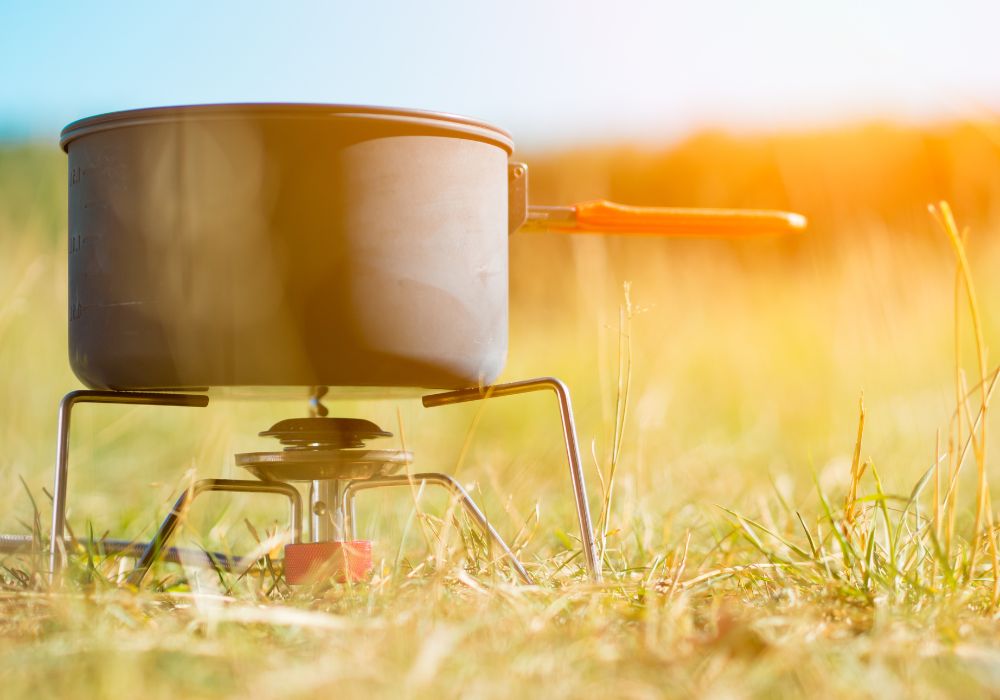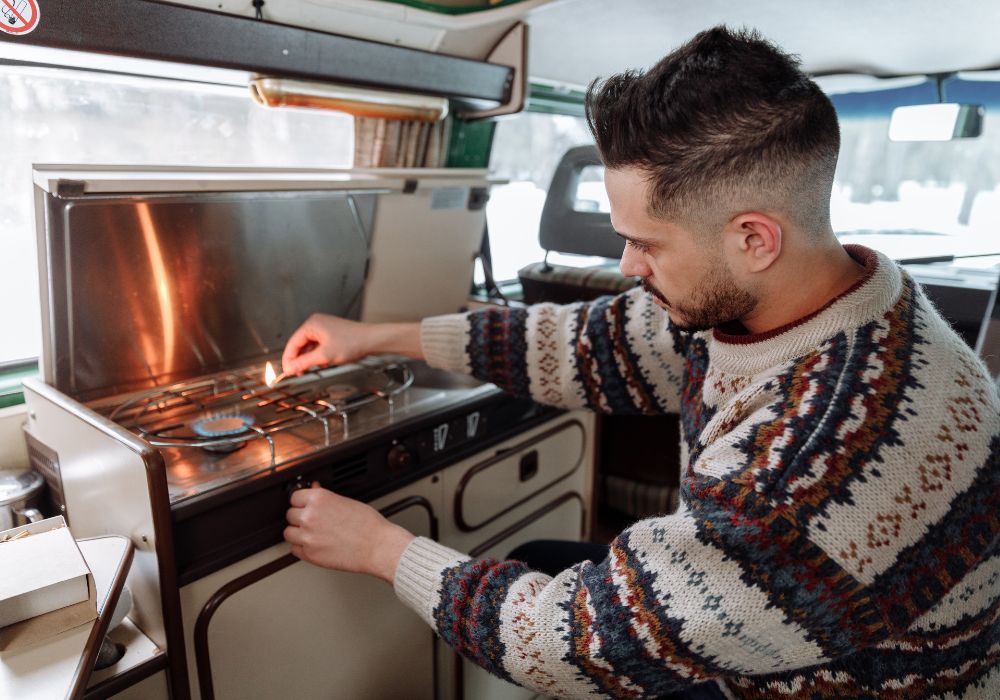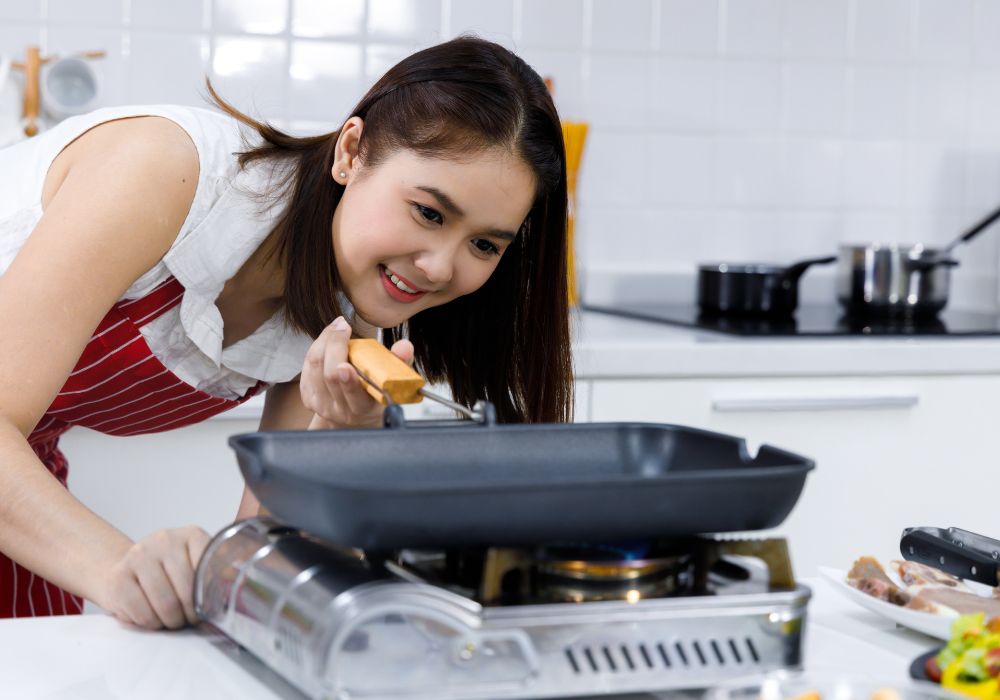Can You Use a Camping Stove Indoors

No, it is not safe to use a camping stove indoors due to the risk of carbon monoxide poisoning. Camping stoves should not be used indoors as they pose a significant risk of carbon monoxide poisoning, a potentially life-threatening condition.
Carbon monoxide is a colorless and odorless gas that can build up in enclosed spaces, leading to symptoms like headaches, nausea, dizziness, and even death. Camping stoves are designed for outdoor use where there is sufficient ventilation to disperse the dangerous fumes.
Using a camping stove indoors can result in the release of carbon monoxide into your living space, which can be particularly dangerous in poorly ventilated areas such as tents, cabins, or small rooms. To ensure your safety, it is essential always to use camping stoves in well-ventilated areas or stick to using indoor-safe alternatives such as portable electric stoves or grills.
Safety Precautions For Indoor Camping Stoves
Indoor camping stoves are convenient but require proper safety precautions. Ensure proper ventilation, keep flammable materials away, use stable surfaces, and always monitor the stove when in use to prevent accidents.
Camping stoves are a convenient and versatile cooking option, but can they be used indoors? While it may seem tempting to bring your camping stove inside during inclement weather or for quick cooking sessions, it’s crucial to prioritize safety. In this section, we will discuss the importance of proper ventilation, the risks associated with carbon monoxide, and essential fire safety precautions to consider when using camping stoves indoors.
Importance Of Proper Ventilation
Indoor use of camping stoves necessitates the presence of adequate ventilation. Without proper airflow, harmful gases can accumulate, potentially leading to carbon monoxide poisoning or fires. Here are some precautions to follow:
- Open windows and doors: Ensure a constant influx of fresh air by keeping doors and windows open. This helps to circulate air and vent any potentially dangerous gases.
- Use fans or exhaust systems: Employ fans or ventilation systems to enhance airflow and remove any lingering fumes. This further aids in maintaining a safe and comfortable environment.
Carbon Monoxide Risks And Prevention Measures
Carbon monoxide (CO) is a colorless and odorless gas produced by burning fuels such as propane or butane. It can build up quickly in enclosed spaces, posing serious health risks. Here’s how to prevent carbon monoxide poisoning:
- Never use camping stoves indoors without proper ventilation: As mentioned earlier, ensure adequate ventilation when using camping stoves indoors.
- Install carbon monoxide detectors: These devices can alert you in case of elevated carbon monoxide levels. Place them near sleeping areas and regularly check that they are functioning correctly.
- Avoid using camping stoves for heating: Using camping stoves as a source of indoor heat increases the risk of carbon monoxide buildup. Instead, use appropriate heating devices designed for indoor use.
Fire Safety Precautions
Camping stoves involve open flames and can present a fire hazard if not used properly. To ensure your safety and the safety of your surroundings, follow these precautions:
- Keep flammable items away: Maintain a safe distance between camping stoves and any flammable materials such as curtains, paper, or furniture.
- Use stable surfaces: Place camping stoves on firm and level surfaces to prevent tipping or accidental fires.
- Never leave unattended: Always stay near the camping stove while it is in use and never leave it unattended. This helps prevent accidents and allows for immediate action if needed.
- Have a fire extinguisher nearby: Keep a fire extinguisher in close proximity to where the camping stove is being used. Familiarize yourself with its operation and ensure it is fully functional.
Remember, safety should always be the top priority when using camping stoves indoors. By following these precautions and using your judgment, you can enjoy the convenience of cooking indoors while minimizing the associated risks. Stay safe and happy cooking!

Choosing The Right Camping Stove For Indoor Use
Finding the perfect camping stove for indoor use is essential. Designed with safety features and proper ventilation, these stoves allow you to enjoy a cozy indoor cooking experience while minimizing risks.
When it comes to using a camping stove indoors, it’s important to choose the right one that prioritizes safety without compromising on functionality. Not all camping stoves are suitable for indoor use, as there are specific features and fuel options to consider.
Understanding these factors will help you make an informed decision when selecting an indoor camping stove. Let’s explore the types of camping stoves that are suitable for indoor use, the fuel options available, and the key features you should consider.
Types Of Camping Stoves Suitable For Indoor Use:
- Propane camping stoves: These stoves are commonly used for outdoor cooking but can also be used indoors with proper ventilation. They are easy to use, provide a consistent heat source, and come with adjustable burners for precise temperature control. Propane camping stoves are often portable and compact, making them ideal for both indoor and outdoor use.
- Electric camping stoves: Designed specifically for indoor use, electric camping stoves are a safe and convenient option. They eliminate the need for open flames and use electricity to generate heat. Electric camping stoves come in various sizes and styles, including portable options, making them versatile for indoor cooking needs.
- Butane camping stoves: Similar to propane stoves, butane camping stoves can be used indoors as long as there is adequate ventilation. They are lightweight, portable, and easy to ignite. Butane stoves typically come with built-in safety features such as automatic shut-off valves to prevent accidents.
Fuel Options For Indoor Camping Stoves:
- Propane: Propane is a popular and easily accessible fuel option for camping stoves. It provides a clean and efficient burn, making it a suitable choice for indoor use. Propane canister refills are widely available, ensuring a steady fuel supply for your indoor adventures.
- Electricity: Electric camping stoves rely on electricity as their fuel source. They can be plugged into a standard power outlet, offering a convenient and reliable option for indoor cooking. However, it’s essential to have a backup power source in case of power outages.
- Butane: Butane is another fuel option suitable for indoor camping stoves. It burns clean and emits low levels of carbon monoxide, making it safe for indoor use. Butane canisters are easily replaceable, ensuring uninterrupted cooking sessions.
Key Features To Consider When Selecting An Indoor Camping Stove:
- Size and portability: Determine if you need a compact and portable camping stove or if a larger, stationary stove will suffice for your indoor cooking needs.
- Safety features: Look for camping stoves with built-in safety measures such as automatic shut-off valves, flame control, and heat-resistant handles to minimize the risk of accidents.
- Temperature control: Opt for camping stoves that offer adjustable burners or temperature control knobs, allowing you to fine-tune the heat for different cooking requirements.
- Ventilation requirements: Ensure that your indoor space has proper ventilation to safely use camping stoves that require it, such as propane or butane stoves.
Choosing the right camping stove for indoor use involves considering the type of stove, fuel options, and essential features. By carefully evaluating these factors, you can enjoy a safe and enjoyable indoor cooking experience with your camping stove.
Benefits And Drawbacks Of Using A Camping Stove Indoors
Using a camping stove indoors can provide convenience and flexibility for cooking, especially during power outages or in small spaces. However, it carries the risk of carbon monoxide poisoning if not properly ventilated, making it crucial to use in well-ventilated areas or with a carbon monoxide detector.
Using a camping stove indoors can be a convenient solution for cooking when faced with power outages, limited living spaces, or when camping in recreational vehicles (RVs). However, it’s crucial to be aware of the benefits as well as the potential drawbacks and risks.
In this section, we will explore the advantages and disadvantages of using a camping stove indoors.
Advantages Of Using A Camping Stove Indoors:
- Convenience for cooking during power outages:
- Easily prepare meals even when the electricity supply is disrupted.
- Cook warm meals and enjoy a hot drink during inclement weather conditions.
- Portable option for small living spaces:
- Ideal for compact kitchens, dorm rooms, or small apartments.
- Offers flexibility to set up your cooking area wherever it’s most convenient.
- Additional cooking option for recreational vehicles:
- Provides an alternative cooking method when RV kitchen facilities are limited or unavailable.
- Cook delicious meals while enjoying your camping adventures.
Disadvantages And Potential Risks Of Using A Camping Stove Indoors:
- Increased fire hazard:
- Open flames and flammable materials indoors pose a higher risk of accidental fires.
- Requires cautious handling and awareness of safety protocols.
- Limited ventilation:
- Lack of proper ventilation can lead to smoke and strong odors permeating the indoor space.
- Ensure adequate airflow to minimize these issues and prevent health risks.
- Health risks associated with carbon monoxide exposure:
- Incomplete combustion of fuel releases carbon monoxide, a dangerous gas.
- Proper ventilation and usage of carbon monoxide detectors are essential to prevent potential harm.
Now that you are aware of the benefits and drawbacks, you can make an informed decision when considering whether to use a camping stove indoors. Ensure you prioritize safety measures, follow guidelines, and take necessary precautions to mitigate any risks associated with indoor cooking using a camping stove.
Stay prepared and enjoy the convenience and versatility it can offer in appropriate settings.
Tips For Safely Using A Camping Stove Indoors
Looking to safely use a camping stove indoors? Follow these tips for a hassle-free experience: ventilate the area, use a carbon monoxide detector, choose a stove with a safety shut-off valve, avoid flammable materials, keep the stove stable, and never leave it unattended.
Enjoy your indoor camping adventure!
Positioning the stove in a well-ventilated area:
- Place the camping stove near a window or any other source of ventilation to ensure proper airflow.
- Avoid using the stove in small, enclosed spaces without adequate ventilation, as this can lead to a build-up of carbon monoxide.
- Always prioritize fresh air circulation to prevent the risk of carbon monoxide poisoning.
Ensuring a stable and level surface for the stove:
- Set up the camping stove on a stable and level surface to prevent any accidents or spills.
- Avoid placing the stove on uneven or flammable surfaces, such as carpets, rugs, or wooden floors.
- Use a heat-resistant mat or a designated stove stand to provide added stability and protection.
Monitoring the stove while in use:
- Never leave the camping stove unattended, especially when it is in use.
- Keep a close eye on the flame and temperature to prevent any mishaps.
- Have a fire extinguisher readily available and familiarize yourself with its operation.
Proper fuel storage and handling:
- Store fuel containers in a cool and well-ventilated area away from any open flames or heat sources.
- Use fuel specifically designed for camping stoves, following the manufacturer’s instructions for proper usage.
- Be cautious when refueling the stove, ensuring that the flame is completely extinguished and the stove has cooled down before adding fuel.
Remember, safety is paramount when using a camping stove indoors. By following these tips, you can minimize any potential risks and enjoy the convenience of cooking indoors without compromising your well-being.
Alternatives To Using A Camping Stove Indoors
Discover safe alternatives to using a camping stove indoors that eliminate the risk of carbon monoxide poisoning, such as electric grills or portable induction cookers. Stay safe and enjoy cooking in the great outdoors!
Are you an avid camper or outdoor enthusiast who loves to cook? Using a camping stove is a convenient way to prepare meals while exploring the great outdoors. However, using a camping stove indoors can be risky and potentially harmful due to the release of carbon monoxide.
If you’re looking for alternatives to using a camping stove indoors, here are a few options to consider:
Electric Camping Stoves:
- Electric camping stoves provide a safe and efficient solution for indoor cooking. These compact stoves are designed for portable use and can be powered by electricity, eliminating the need for open flames or fuel combustion. They are easy to use and typically offer temperature control options, making them suitable for various cooking styles.
- Electric camping stoves are versatile and can be used in various indoor settings such as RVs, cabins, or even in your kitchen as a backup cooking option during power outages.
- With no fuel or gas required, electric camping stoves are eco-friendly and don’t produce any harmful emissions. They are also easy to clean, as there is no residue left from burning fuels.
Portable Induction Cooktops:
- Portable induction cooktops offer another safe and efficient alternative for indoor cooking. These innovative cooktops use electromagnetic fields to directly heat the cookware, ensuring fast and precise cooking without generating excess heat.
- Induction cooktops are energy-efficient, as they only heat the cookware directly, reducing wasted energy. They also provide precise temperature control and instant heat adjustment, allowing for more accurate and controlled cooking.
- Portable induction cooktops are usually lightweight and compact, making them highly portable and perfect for indoor use in small spaces such as dorm rooms, studio apartments, or even during camping trips with access to electricity.
Utilizing A Microwave Or Slow Cooker For Indoor Cooking:
- Microwaves and slow cookers are excellent alternatives for indoor cooking without the need for a camping stove. These appliances are designed for easy and convenient meal preparation.
- Microwaves offer quick heating and reheating options, making them ideal for heating pre-made meals or leftovers. They are also great for steaming vegetables, defrosting foods, and even cooking simple recipes.
- Slow cookers, also known as crockpots, are perfect for flavorful and slow-cooked meals. With their low and slow cooking method, you can easily prepare stews, soups, casseroles, and more. Just set it and forget it, allowing the flavors to develop over time.
- Both microwaves and slow cookers are safe to use indoors, so you can enjoy indoor cooking without the need for open flames or combustion.
These alternatives provide safe and practical options for cooking indoors without the risk of using a camping stove. Whether you opt for an electric camping stove, portable induction cooktop, microwave, or slow cooker, you can still prepare delicious meals while keeping safety in mind.
So, get creative with your indoor cooking and explore the possibilities of these alternative cooking methods!
Best Practices For Indoor Camping Stove Usage
Indoor camping stove usage requires certain best practices to ensure safety. While it is possible to use a camping stove indoors, precautions such as proper ventilation and carbon monoxide monitoring are crucial to prevent hazardous situations.
Regular maintenance and cleaning:
- Clean the camping stove thoroughly before and after each use to ensure the best performance and prevent any buildup of dirt or debris.
- Regularly inspect the burners, fuel lines, and other parts of the stove for any signs of damage or wear. Replace any damaged components promptly.
- Check the fuel canisters for leaks by applying a soapy solution to the connections and looking for any bubbles. If you detect a leak, discontinue use and repair or replace the faulty parts.
- Remove any leftover fuel from the stove when not in use to minimize the risk of fire or gas leaks.
Storing the camping stove properly:
- Store the camping stove in a cool, dry place to protect it from moisture and rust. Avoid storing it in extreme temperatures, such as in a hot vehicle or freezing conditions.
- Keep the stove away from flammable materials and ensure proper ventilation in the storage area to prevent the accumulation of gas fumes.
- Store the stove in a secure location to prevent accidental damage or tampering, especially if there are children or pets present.
Familiarizing yourself with the specific instructions and safety guidelines provided by the manufacturer:
- Read and understand the user manual provided by the camping stove manufacturer. Follow their instructions for setup, operation, and maintenance.
- Take note of any specific safety precautions, such as minimum ventilation requirements or recommended fuel types.
- Adhere to the manufacturer’s guidelines for use in indoor environments. Some camping stoves may not be designed for indoor use, so ensure that the stove you have is suitable for indoor settings.
- Keep the manufacturer’s contact information readily available in case you have any questions or need assistance.
By following these best practices, you can safely and effectively use a camping stove indoors. Regular maintenance, proper storage, and adherence to manufacturer’s guidelines will ensure a pleasant and worry-free indoor camping experience.

Credit: outdoors.com
Frequently Asked Questions On Can You Use A Camping Stove Indoors
Can You Use A Camping Stove Indoors?
Yes, you can use a camping stove indoors, but it is important to take safety precautions. Make sure the area is well-ventilated, avoid using it in enclosed spaces, and never leave it unattended. Also, be cautious of any potential fire hazards and keep a fire extinguisher nearby.
Conclusion
It is NOT safe to use a camping stove indoors. Although it may seem convenient in certain situations, the risks outweigh the benefits. The primary concern is the potential release of carbon monoxide, which is a colorless and odorless gas that can be deadly if inhaled in high concentrations.
Indoor areas lack proper ventilation compared to the outdoors, making it easier for the gas to accumulate and pose a serious threat. Additionally, using a camping stove indoors increases the risk of starting a fire and causing burns or injuries.
It is essential to prioritize safety and adhere to the manufacturer’s instructions and guidelines. Instead, consider using alternative cooking methods such as electric cookers or portable induction stoves that are specifically designed for indoor use. Always prioritize your well-being by ensuring proper ventilation and utilizing appropriate cooking equipment for each environment.










Using camping stoves indoors can be unsafe due to the risk of carbon monoxide poisoning and fire hazards. The safety depends on the type of fuel. Propane, kerosene, alcohol, and isobutane-propane stoves emit carbon monoxide and need ventilation. Wood-burning stoves are safer but require fire safety precautions.
Using a camping stove indoors can be hazardous to your health. Carbon monoxide, a colorless and odorless gas, can be released into your living space, which can be particularly dangerous in poorly ventilated areas such as tents, cabins, or small rooms. To ensure your safety, it is essential always to use camping stoves in well-ventilated areas or stick to using indoor-safe alternatives such as portable electric stoves or grills.
When using indoor camping stoves, it is important to take proper safety precautions. Here are some essential safety tips to consider:
Proper ventilation: Always use your camping stove in a well-ventilated area. Open windows and doors to allow fresh air to circulate and prevent the buildup of carbon monoxide2.
Keep flammable materials away: Keep flammable materials such as paper, cloth, and other combustibles away from the stove to prevent accidental fires.
Use stable surfaces: Place your stove on a stable surface to prevent it from tipping over and causing accidents.
Monitor the stove when in use: Always keep an eye on the stove when it is in use to prevent accidents.
Remember, camping stoves are a convenient and versatile cooking option, but they should never be used indoors without proper ventilation. Prioritizing safety is crucial to ensure a safe and enjoyable camping experience.